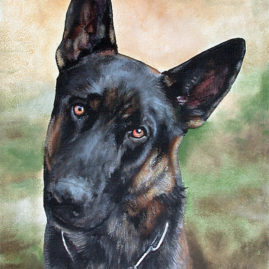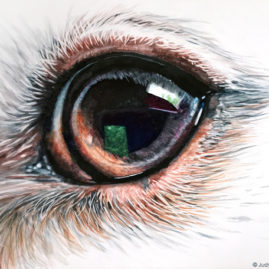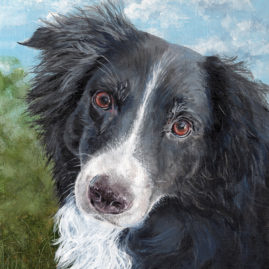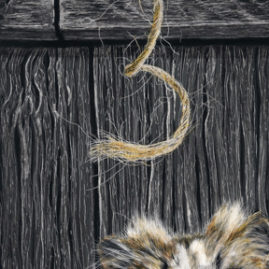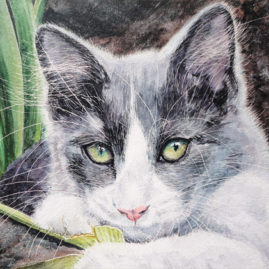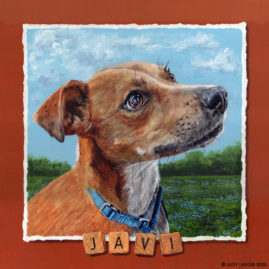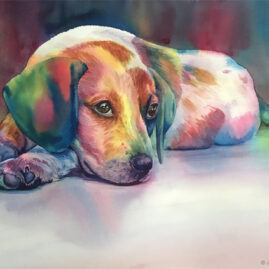-
MEDIUM: Watercolor on Aquabord™ with Scratching
-
SIZE: 14" x 11"
-
STATUS: Sold
-
ACCOLADES: This painting was juried into the 52nd Annual Oak Ridge (TN) Open Show. In accepting this entry for the exhibition, juror Kim Winkle gave it the following critique: "Really meticulous detail and surfaces. Remarkable use of watercolor and technique. Wonderful use of multiple colors on the dog but still looks like a natural colored animal. Excellent color technique. Amazing use of materials...."
"I've taken many photos of our friends' dog Foster over the years, hoping someday to capture his beauty in a painting.
After a few paintings depicting blown soap bubbles in watercolor on paper, I decided it was time try this challenging subject on white scratchboard. I liked my results on little test panels. The approach was totally different from painting blown bubbles on watercolor paper, due to the nature of creating white areas. One aspect which I love about painting with watercolor on a clay-coated white Aquabord™ is that I can cover the entire surface with paint (even spots which will eventually be white) and then use many methods to remove the paint and uncover the pure white areas below. I can re-wet the paint and easily lift it away. I can use any abrasive tool to scratch the paint off to reveal white. These characteristics of white scratchboard make my painting process differ from creating the same painting on paper, where whites are preserved as unpainted areas.
My approach to creating this portrait of Foster was to complete about 90% of the paint application first, then use my removal techniques to uncover whites. For example, I painted the entire leafy background before adding any bubbles. I'll reveal my secret "bubble method" here: I use a plastic circle template, strategically positioned and held firmly in place. Then I used a careful stroke with a long straight sharp needle (sold as an upholstery tool) held straight, tracing the template shape to scratch a fine white circle through the paint layer. Before removing the template, I also use one or more clean dampened Q-tips to remove some of the watercolor pigment, by lightly rubbing just within the circle outline. Once I take the template off I continue to reveal white areas within the bubble with various techniques: re-wetting the paint and lifting it off as described above, scratching with a curved knife blade for a hard edged spot or rubbing with a fiberglass brush for a soft edged spot… whatever seems to work best for the effect I want. In my R&D phase of studying bubbles, I observed that they are largely defined by their reflections, not only of the objects around them but with the bright array of rainbow colors which I presume are a result of the soap particles. So my final step of depicting the bubbles is to cover most of the revealed whites with bright clean transparent colors. For Foster's fur, eyes, nose, mouth, and collar, white scratchboard is a natural. You can read many of my blog posts about the advantages of painting on white scratchboard for animal paintings.
Foster truly has a heart of gold, but see if you can find a gold heart shape hidden in the painting itself!"

